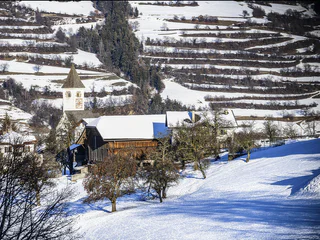
1/4
Church St Mary Magdalene´s in Tagusens
Castelrotto/Kastelruth, Kastelruth/Castelrotto, Dolomites Region Seiser Alm
Sur les traces de notre histoire, tu te baladeras dans des châteaux et des forteresses, tu visiteras des églises et des monastères et tu découvriras, lors de visites guidées, des témoins de l'époque, des bâtiments et des places dignes d'intérêt. Inspirées par les anciens et les nouveaux maîtres, les coutumes et l'actualité, les différentes manifestations culturelles telles que les expositions, le théâtre, la danse et la musique t'invitent à échanger avec l'art et la culture.

1/4
Castelrotto/Kastelruth, Kastelruth/Castelrotto, Dolomites Region Seiser Alm

1/4
Tagusa/Tagusens, Kastelruth/Castelrotto, Dolomites Region Seiser Alm

Dobbiaco Nuova/Neutoblach, Toblach/Dobbiaco, Dolomites Region 3 Zinnen

1/3
San Vigilio, Al Plan/San Vigilio, Dolomites Region Kronplatz/Plan de Corones

1/3
Valdaora di Sopra/Oberolang, Olang/Valdaora, Dolomites Region Kronplatz/Plan de Corones

S.Cristina Gherdëina/S.Cristina Val Gardena/S.Cristina Gherdëina/St.Christina in Gröden, S.Crestina Gherdëina/Santa Cristina Val Gardana, Dolomites Region Val Gardena

1/2
Selva/Sëlva/Wolkenstein/Sëlva, Sëlva/Selva di Val Gardena, Dolomites Region Val Gardena

1/7
Villabassa/Niederdorf, Niederdorf/Villabassa, Dolomites Region 3 Zinnen

1/3
Fiè/Völs, Völs am Schlern/Fiè allo Sciliar, Dolomites Region Seiser Alm

1/2
Tisana/Tisens, Kastelruth/Castelrotto, Dolomites Region Seiser Alm

1/2
Badia/Badia, Badia, Dolomites Region Alta Badia

1/3
S.Cristina Gherdëina/S.Cristina Val Gardena/S.Cristina Gherdëina/St.Christina in Gröden, S.Crestina Gherdëina/Santa Cristina Val Gardana, Dolomites Region Val Gardena

Villa Ottone/Uttenheim, Gais, Dolomites Region Kronplatz/Plan de Corones

1/4
Brunico città/Bruneck Stadt, Bruneck/Brunico, Dolomites Region Kronplatz/Plan de Corones

1/3
Brunico città/Bruneck Stadt, Bruneck/Brunico, Dolomites Region Kronplatz/Plan de Corones

1/5
Villabassa/Niederdorf, Niederdorf/Villabassa, Dolomites Region 3 Zinnen

Rasun di Sopra/Oberrasen, Rasen-Antholz/Rasun Anterselva, Dolomites Region Kronplatz/Plan de Corones

1/2
Dobbiaco Nuova/Neutoblach, Toblach/Dobbiaco, Dolomites Region 3 Zinnen

Bula/Bulla/Bula/Pufels, Urtijëi/Ortisei, Dolomites Region Val Gardena

1/6
S. Maddalena/St. Magdalena - Funes/Villnöss, Villnöss/Funes, Dolomites Region Kronplatz/Plan de Corones

Dobbiaco Nuova/Neutoblach, Toblach/Dobbiaco, Dolomites Region 3 Zinnen

Dobbiaco Nuova/Neutoblach, Toblach/Dobbiaco, Dolomites Region 3 Zinnen

1/9
S. Sigismondo/St. Sigmund, Kiens/Chienes, Dolomites Region Kronplatz/Plan de Corones

Selva/Sëlva/Wolkenstein/Sëlva, Sëlva/Selva di Val Gardena, Dolomites Region Val Gardena

1/3
Campolino/Lothen, St.Lorenzen/San Lorenzo di Sebato, Dolomites Region Kronplatz/Plan de Corones

1/2
La Val/La Val, La Val, Dolomites Region Alta Badia

1/10
Selva/Sëlva/Wolkenstein/Sëlva, Sëlva/Selva di Val Gardena, Dolomites Region Val Gardena

1/2
Bula/Bulla/Bula/Pufels, Urtijëi/Ortisei, Dolomites Region Val Gardena

1/2
Niederdorf/Villabassa, Dolomites Region 3 Zinnen

1/2
Castelrotto/Kastelruth, Kastelruth/Castelrotto, Dolomites Region Seiser Alm